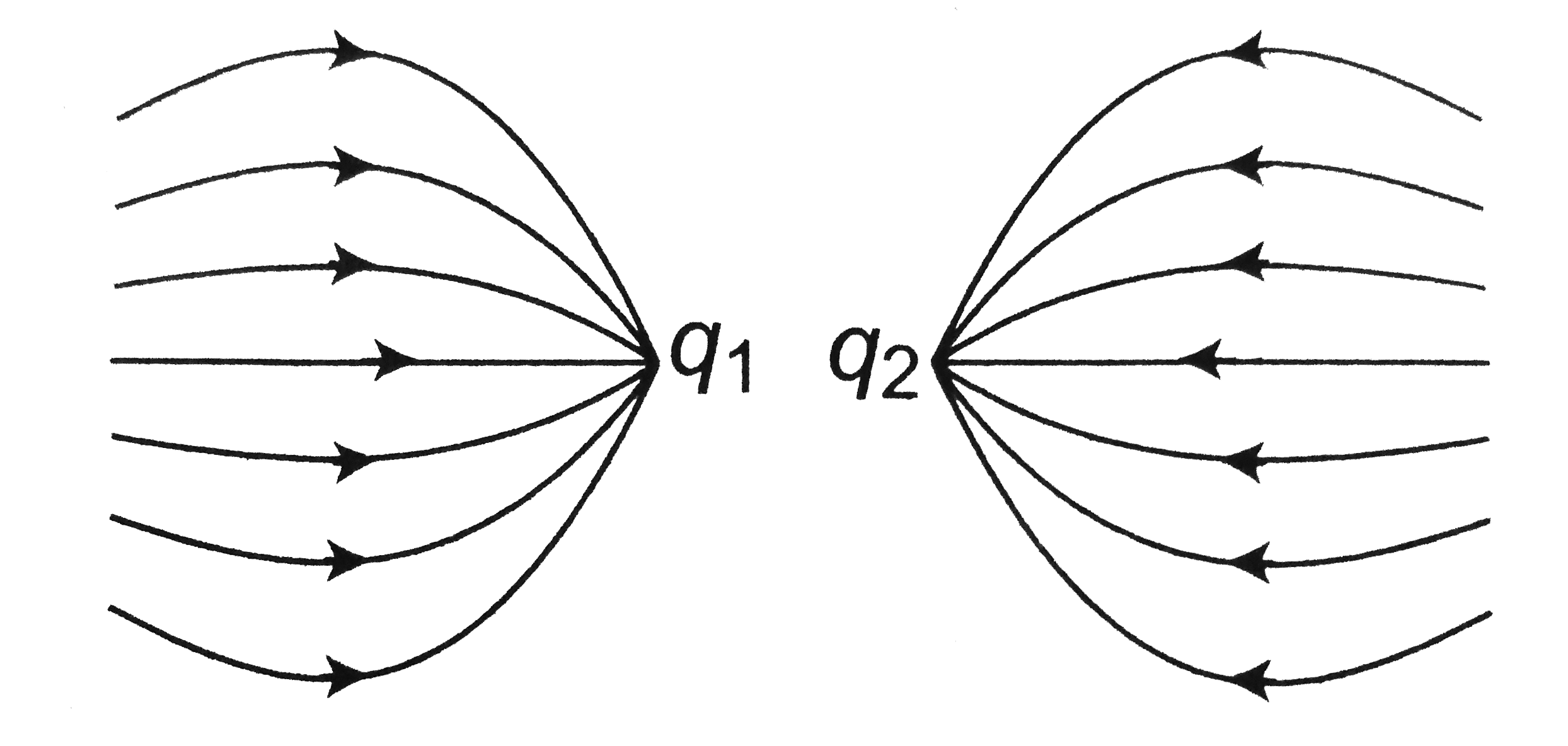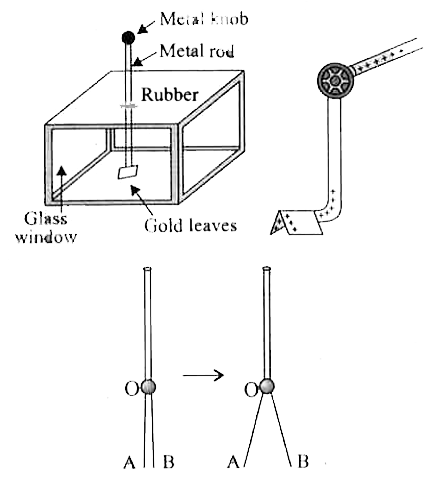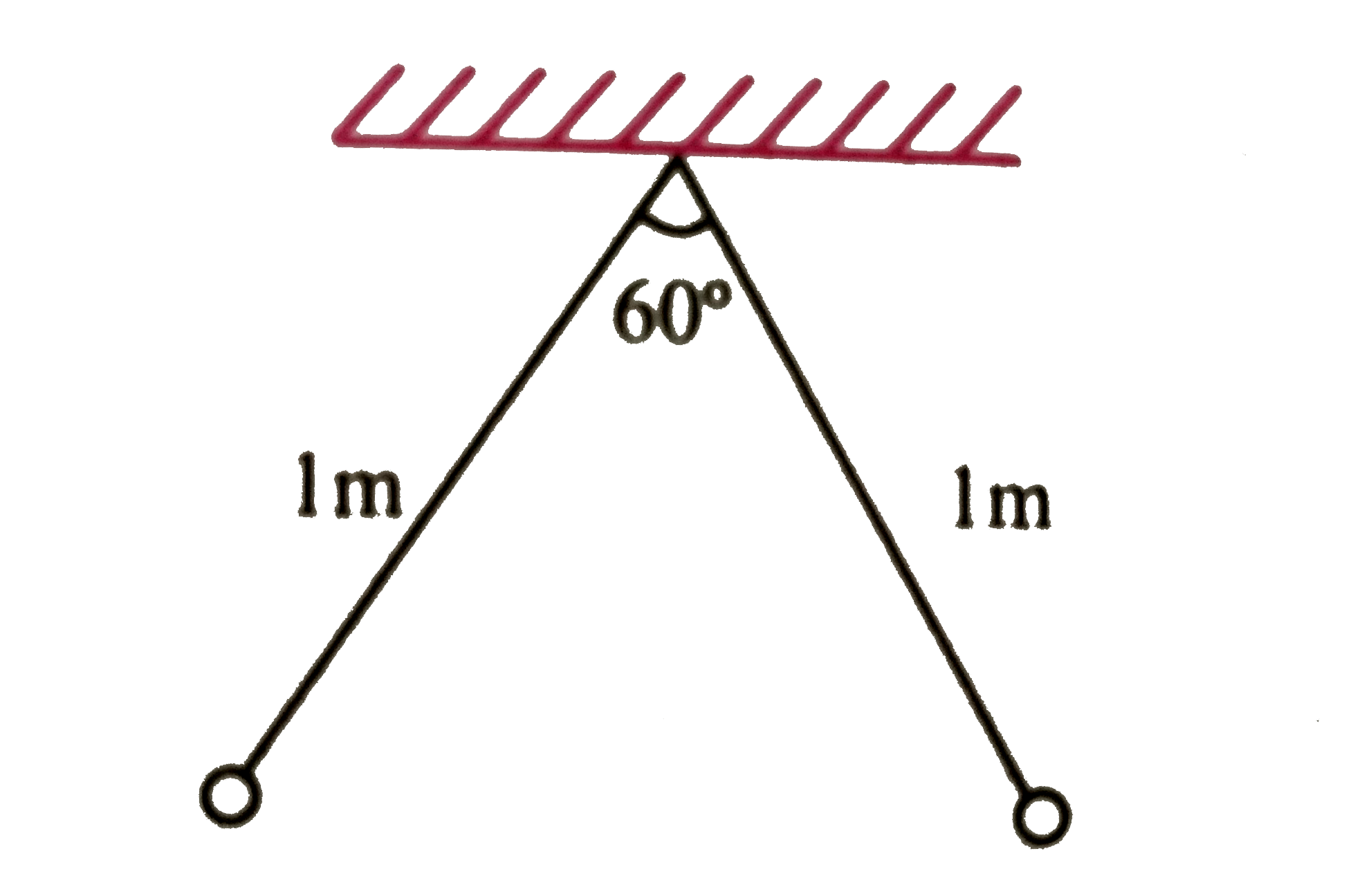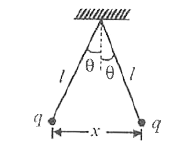Two small spherical balls each carrying a charge Q=10μC are suspended by two insulating threads of equal lengths 1cm each, from a point fixed in the ceiling. It is found that in equilibrium threads are sepreated by an angle 60∘ between them, as shown in figure. What is the tension in the threads
(Given 14πε0=9×109Nm/C2 )

18 N
1.8 N
0.18 N
None of the above
The correct Answer is:B
Step by step video solution for Two small spherical balls each carrying a charge Q= 10 mu C are suspended by two insulating threads of equal lengths 1 cm each, from a point fixed in the ceiling. It is found that in equilibrium threads are sepreated by an angle 60^(@) between them, as shown in figure. What is the tension in the threads (Given (1)/(4piepsilon_(0))= 9xx10^(9)Nm//C^(2) ) by Physics experts to help you in doubts & scoring excellent marks in Class 12 exams.
Updated on:21/07/2023Topper's Solved these Questions
- COULOMB LAW AND ELECTRIC FIELDBook:CENGAGE PHYSICS ENGLISHChapter:COULOMB LAW AND ELECTRIC FIELDExercise:Multiple Correct Answer Type
Explore 1 Video
- COULOMB LAW AND ELECTRIC FIELDBook:CENGAGE PHYSICS ENGLISHChapter:COULOMB LAW AND ELECTRIC FIELDExercise:Single Answer Correct Type
Explore 22 Videos
- COULOMB LAW AND ELECTRIC FIELDBook:CENGAGE PHYSICS ENGLISHChapter:COULOMB LAW AND ELECTRIC FIELDExercise:Comprehension Type
Explore 2 Videos
- CENGAGE PHYSICS DPPBook:CENGAGE PHYSICS ENGLISHChapter:CENGAGE PHYSICS DPPExercise:single correct type
Explore 14 Videos
- ELECTRIC CURRENT & CIRCUITSBook:CENGAGE PHYSICS ENGLISHChapter:ELECTRIC CURRENT & CIRCUITSExercise:Kirchhoff s law and simple circuits
Explore 15 Videos
Similar Questions
When two point charges qA and qB are placed at some separation on positive x-axis at points (xA,0) and (xB,0). Given that |qA| and |qB| and xB>xA. If null point is the point where net electric field due to both the charges is zero, then
View SolutionThe given figure gives electric line of force due to two charges q1 and q2. What are the signs of the two charges ?

View SolutionA leaf electroscope is a simple apparatus to detect any charge on a body. It consist of two metal leaves OA and OB, free to rotate about O. Initially both are very slighty separted. When a charged object is touched to the metal knob at the top of the conduction re, charge flows from knob to the top of the conduction rod, charge flows from knob to the leaves through the conducting rod, charge flows from knob to the leaves through the conduction rod. As the leaves are now charged similarly, they start repelling each other and tet separted (deflected by certain angle).

The angle of deflection in static equilibrium is an indicator of the amount of charge on the charged boy.
When a+20C rod is touched to the knob, the deflection of leaves was 5∘, and when an identical rod of −40C is touched, the deflection was found to be 9∘. If an identical rod of +30C is touched, then the deflection may be:
View Solutionddx(√x+1√x)2=
View SolutionIn the circuit element given here, if the potential at point B, VB=0, then the potentials of A and D are given as ltBrgt

View SolutionTwo small balls, each having charge q, are suspended by two insulating threads of equal length L fron a hook in an elevator. The elevator is freely falling. Calculate the angle etween the two threads and tension in each thread.
View SolutionTwo small spherical balls each carrying a charge Q=10μC( 10 micro=coulomb) are suspended by two insulating threads of equal lengths 1cm each, from a point fixed in the ceiling. It is found that in equilibrium threads are sepreated by an angle 60∘ between them, as shown in figure. What is the tension in the threads
(Given 14πε0=9×109Nm/C2 )

View SolutionTwo pith ball of mass 0.5 each are suspended from a common point O by means of silk threads, each of length 20 cm. When the balls are given equal and similar charges, they repel each other so that the two threads make an angle of 60∘ with each-other. Determine the charge on each ball.
View SolutionAssertion : Two identical balls are charged by q. They are suspended from a common point by two insulating threads l each. In equilibrium, the angle between the tension in the threads is 180^(@) . (Ignore gravity). Reason : In equilibrium tension in the spring is T=1/(4pi epsi_(0)) (q.q)/l^(2)
View Solutionदो छोटे गोले, जिनमे से प्रत्येक पर 10μC का आवेश है, एक-एक मीटर लम्बे धागे की सहायता से किसी छत से इस प्रकार लटकाये जाये कि साम्यावस्था में धागों के बीच 60∘ का कोण बनाता है। तब प्रत्येक धागे पर तनाव होगा -

View SolutionTwo small identical balls, each of mass 0.20 g, carry identical charges and are suspended by two threads of equal lengths. The balls position themselves at equilibirum such that the angle between the threads is 60∘. If the distance between the balls is 0.5 m, find the charge on each ball.
View Solutionदो छोटी गोलाकार गेंदें, जिनमें प्रत्येक पर आवेश Q = 10 uC है, एक-एक मीटर लम्बाई के दो कुचालक धागों की सहायता से छत पर एक बिन्दु से लटकायी जाती हैं। साम्यावस्था में ये धागे एक-दूसरे से कोण 60° पर पृथक् हो जाते हैं । प्रत्येक धागे में तनाव होगा :

View SolutionTwo similar balls are suspended from a point by two silk thread, each of length l. Each ball of mass m contains q amount of charge. If the angle between the two threads is very small, show that the distance between the centres of the two balls at equilibrium is x=(2q2lmg)1/3
View SolutionTwo identical spheres, each of mass m, are suspended from a point by threads. Each sphere carries a charge q. If the angle between the threads is very small, prove that in equilibrium, the distance between the centres of the two spheres is, x=((q^(2)l)/(2pi epsilon_(0)mg))^((1)/(3))
View Solutionदो समान छोटी गेंदें, प्रत्येक का द्रव्यमान m तथा प्रत्येक पर आवेश q सिल्क के धागों से (प्रत्येक धागे की लम्बाई l) चित्र के अनुसार लटकाई गई है। इनके मध्य दूरी x और धागों के मध्य कोण (2θ=10∘) है। तब साम्यावस्था की स्थिति में दूरी x का मान ज्ञात करो।

View Solutionदो समान छोटी गेंदे, प्रत्येक का द्रव्यमान m तथा प्रत्येक पर आवेश q सिल्क के धागों से (प्रत्येक धागे की लम्बाई l) चित्र के अनुसार लटकाई गई है इनके मध्य दूरी x और धागों के मध्य कोण (2θ≈10∘) है। तब साम्यावस्था की स्थिति में दूरी x का मान ज्ञात करो।

View Solution
